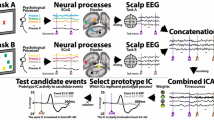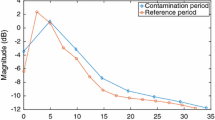Abstract
Muscle or electromyogenic (EMG) artifact poses a serious risk to inferential validity for any electroencephalography (EEG) investigation in the frequency-domain owing to its high amplitude, broad spectrum, and sensitivity to psychological processes of interest. Even weak EMG is detectable across the scalp in frequencies as low as the alpha band. Given these hazards, there is substantial interest in developing EMG correction tools. Unfortunately, most published techniques are subjected to only modest validation attempts, rendering their utility questionable. We review recent work by our laboratory quantitatively investigating the validity of two popular EMG correction techniques, one using the general linear model (GLM), the other using temporal independent component analysis (ICA). We show that intra-individual GLM-based methods represent a sensitive and specific tool for correcting on-going or induced, but not evoked (phase-locked) or source-localized, spectral changes. Preliminary work with ICA shows that it may not represent a panacea for EMG contamination, although further scrutiny is strongly warranted. We conclude by describing emerging methodological trends in this area that are likely to have substantial benefits for basic and applied EEG research.


Similar content being viewed by others
References
Barbati G, Porcaro C, Hadjipapas A, Adjamian P, Pizzella V, Romani GL, Seri S, Tecchio F, Barnes GR (2008) Functional source separation applied to induced visual gamma activity. Hum Brain Mapp 29:131–141
Crespo-Garcia M, Atienza M, Cantero JL (2008) Muscle artifact removal from human sleep EEG by using independent component analysis. Ann Biomed Eng 36:467–475
De Clercq W, Vergult A, Vanrumste B, Van Hees J, Palmini A, Van Paesschen W, Van Huffel S (2005) A new muscle artifact removal technique to improve the interpretation of the ictal scalp electroencephalogram. Conf Proc IEEE Eng Med Biol Soc 1:944–947
Delorme A, Sejnowski T, Makeig S (2007) Enhanced detection of artifacts in EEG data using higher-order statistics and independent component analysis. Neuroimage 34(4):1443–1449
Fatourechi M, Bashashati A, Ward RK, Birch GE (2007) EMG and EOG artifacts in brain computer interface systems: a survey. Clin Neurophysiol 118:480–494
Fitzgibbon SP, Powers DMW, Pope KJ, Clark CR (2007) Removal of EEG noise and artifact using blind source separation. J Clin Neurophysiol 24:232–243
Goncharova II, McFarland DJ, Vaughan TM, Wolpaw JR (2003) EMG contamination of EEG: spectral and topographical characteristics. Clin Neurophysiol 114:1580–1593
Grouiller F, Vercueil L, Krainik A, Segebarth C, Kahane P, David O (2007) A comparative study of different artefact removal algorithms for EEG signals acquired during functional MRI. Neuroimage 38:124–137
Hu D, Yan L, Liu Y, Zhou Z, Friston KJ, Tan C, Wu D (2005) Unified SPM-ICA for fMRI analysis. Neuroimage 25:746–755
Li Y-O, Adal T, Calhoun VD (2008) Estimating the number of independent components for functional magnetic resonance imaging data. Hum Brain Mapp 28:1251–1266
Lutz A, Greischar LL, Rawlings NB, Ricard M, Davidson RJ (2004) Long-term meditators self-induce high-amplitude gamma synchrony during mental practice. Proc Natl Acad Sci USA 101(46):16369–16373
Makeig S, Debener S, Onton J, Delorme A (2004) Mining event-related brain dynamics. Trends Cogn Sci 8:204–210
Mammone N, Morabito FC (2008) Enhanced automatic artifact detection based on independent component analysis and Renyi’s entropy. Neural Netw 21:1029–1040
McMenamin BW, Shackman AJ, Maxwell JS, Greischar LL, Davidson RJ. (in press). Validation of regression-based myogenic correction techniques for scalp and source-localized EEG. Psychophysiology
Pizzagalli DA (2007) Electroencephalography and high-density electrophysiological source localization. In: Cacioppo JT, Tassinary LG, Berntson GG (eds) Handbook of psychophysiology. Cambridge University Press, NY, pp 56–84
Seaman MA, Serlin RC (1998) Equivalence confidence intervals for two-group comparisons of means. Psychol Methods 3(4):403–411
Tassinary LG, Cacioppo JT, Vanman EJ (2007) The skeletomotor system: surface electromyography. In: Cacioppo JT, Tassinary LG, Berntson GG (eds) Handbook of psychophysiology, 3rd edn. Cambridge University Press, NY, pp 267–302
Whitham EM, Pope KJ, Fitzgibbon SP, Lewis T, Clark CR, Loveless S, Broberg M, Wallace A, DeLosAngeles D, Lillie P, Hardy A, Fronsko R, Pulbrook A, Willoughby JO (2007) Scalp electrical recording during paralysis: quantitative evidence that EEG frequencies above 20 Hz are contaminated by EMG. Clin Neurophysiol 118(8):1877–1888
Whitham EM, Lewis T, Pope KJ, Fitzgibbon SP, Clark CR, Loveless S, DeLosAngeles D, Wallace AK, Broberg M, Willoughby JO (2008) Thinking activates EMG in scalp electrical recordings. Clin Neurophysiol 119(5):1166–1175
Acknowledgments
This work was supported by NIMH grants P50-MH52354 and MH43454. We thank David Bachhuber, Bridget Kelly, and Adam Koppenhaver for assistance.
Author information
Authors and Affiliations
Corresponding author
Additional information
This article is one of five on the “Special Topic: Discussing Gamma” in issue 21(3) of Brain Topography.
Rights and permissions
About this article
Cite this article
Shackman, A.J., McMenamin, B.W., Slagter, H.A. et al. Electromyogenic Artifacts and Electroencephalographic Inferences. Brain Topogr 22, 7–12 (2009). https://doi.org/10.1007/s10548-009-0079-4
Received:
Accepted:
Published:
Issue Date:
DOI: https://doi.org/10.1007/s10548-009-0079-4




